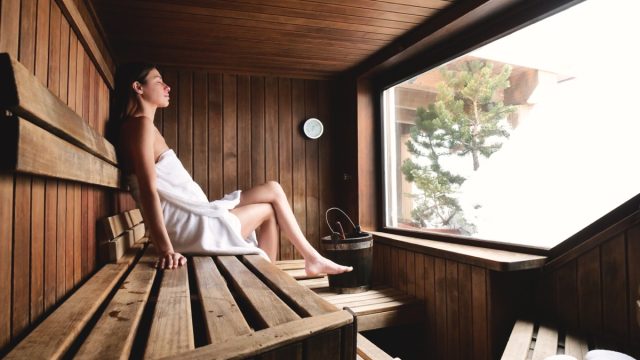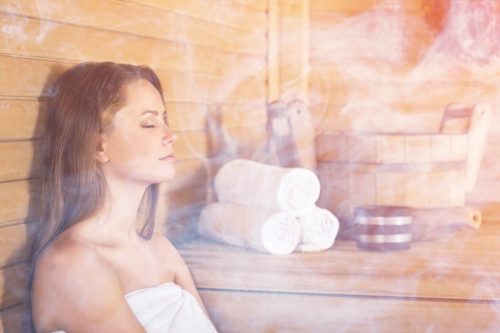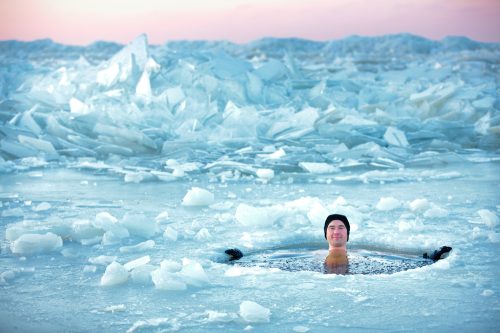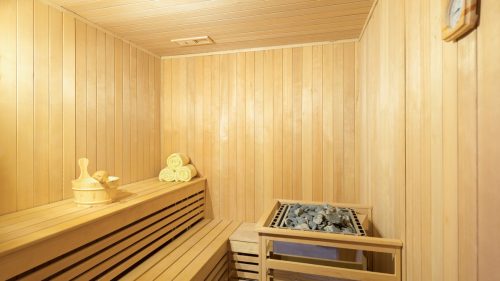9 Amazing Health Benefits of Saunas

Saunas have long been said to have mystical healing properties, and in places like Scandinavia and Eastern Europe, their popularity is so widespread that many people have them installed in their homes or backyards.
A brief history: Saunas were once very popular all over Europe, but when plague spread in the 1500s, its popularity died out everywhere except Finland (which was spared of these communicable diseases), which is why the sauna is now so closely culturally associated with that country.
Traditional Finnish saunas are a small, wooden room, in which wood is burned for several hours, and the smoke is released, leaving behind an arid, extreme heat that hovers between 160 and 220 degrees Fahrenheit. One would sit in the sauna for no less than five but no more than thirty minutes, sweating and occasionally throwing water from a bucket onto a pile of hot rocks to give off steam and a sense of increased temperature, then emerge to either jump into an ice pool, rinse off with a cold shower, or, if you’re very traditional, jump into a mound of fresh snow.
While it may look a bit bizarre to an outsider, the process is not only fun, but it has several incredible health benefits. Keep reading to discover what they are.
READ THIS NEXT: The FDA Says These Bathroom Soaps Expose You to “Unnecessary Chemicals”.
How Many Different Types of Saunas Are There?
Traditional Finnish saunas are not the only game in town. Many people swear by infrared saunas. These types of saunas generate heat using light, and don’t get as hot as a Finnish sauna does. “Generally, people like saunas because they cause reactions like those caused by moderate exercise, such as vigorous sweating and an increased heart rate,” the Mayo Clinic explains. “An infrared sauna gives these results at lower temperatures than does a regular sauna.”
The Mayo Clinic experts write that “many studies have looked at using infrared saunas in the treatment of long-lasting health problems and found some proof that saunas may help.” Conditions they say may be improved with regular sauna use include high blood pressure, heart failure, dementia (including Alzheimer’s disease, the number-one cause of dementia), headache, Type 2 diabetes, and arthritis. They also point out that these studies were done using both infrared saunas and traditional saunas that use wood or heated rocks to create heat.
Sauna vs. Steam room
Some people confuse saunas with steam rooms, which are completely different—although you are likely to find both in a spa. While a sauna uses dry heat, steam rooms are, well, steamy. Think about the difference between a desert and a jungle.) “While a sauna may help you relax and loosen your muscles, a steam room may have even further health benefits,” Healthline writes. “The key to the steam room’s unique health benefits is the humidity. Steam rooms are wet and tropical-like.”
9 Benefits of Using a Sauna
1. It’s a heart-healthy habit.

According to a 2018 study from the University of Eastern Finland, a 30-minute sauna session can have the same effects on your heart and blood vessels as moderate exercise, which is why those who frequent the sauna tend to have lower blood pressure, an increased heart rate, and lower risk of heart disease.
The sweating, researcher Tanjaniina Laukkanen explained, has “a natural diuretic effect — lowering blood pressure and decreasing the work load of the heart.”
2. It helps keep your brain sharp.

In a more surprising discovery, Laukkanen’s team found that sauna regulars had lower rates of Alzheimer’s disease and dementia, thanks in large part to the fact that the sauna lowers your blood pressure. “Both the heart and the brain need good blood vessel function,” Laukkanen said.
READ THIS NEXT: Alzheimer’s Has No Cure—But a New Study Just Found Something That May Reverse It.
3. It keeps your blood moving.

The study used 102 people in their 40s and 50s who did not have heart disease but did have risk factors for it, such as high blood pressure, high cholesterol, or obesity, and exposed them to a single Finnish sauna session.
They found that the just one session made an average participant’s blood pressure drop by seven points, elasticized their arteries, and helped their heart rate go from 65 bpm to 81.
Joshua Liberman, MD, a cardiologist and governor of the American College of Cardiology’s Wisconsin, said the long-term cardiovascular benefits of frequent saunas sessions can be attributed to the way in which extreme heat in small doses causes the blood vessels relax and blood flow to increase.
For more health news sent directly to your inbox, sign up for our daily newsletter.
4. It’s relaxing.

Anyone who’s ever stepped inside the sauna at their gym knows lying with your eyes closed in this warm, dry room can be extremely meditative, and that’s part of what makes it so therapeutic. It helps that you can’t bring electronics with you into the sauna as well, allowing you to truly escape and unwind from the outside world.
5. It eases sore muscles.

This is especially true if you opt to use a venik, aka a bundle of birch leaves which have been soaked in water, and which an experienced “beater” will gently pat over your entire body in a traditional Russian treatment known as venik platza.
While it may appear bizarre, the effects of a platza treatment are immediately astounding, as it increases your internal body heat, relieves sore muscles, improves blood circulation, and decongests the lungs. While it looks medieval, it’s not painful, and afterwards you feel like you’ve been reborn.
6. It’ll leave your skin glowing.

The sauna can help “open up your pores and increase blood and lymphatic circulation, which will effectively aid in softening your skin,” explains health and beauty researcher Qurratulain Zaheer. “You will notice a healthy pink glow in your skin, which will make you look younger, so not only will you feel good but you will also look rejuvenated.”
A single session can also get rid of blackheads, and flush out toxins, thereby leading to smooth, healthy skin.
7. It can help you lose weight.

While it won’t help you burn fat, the sweating that you do in the sauna does help you lose a bit of water weight, which can make you feel considerably lighter, especially after a weekend of overindulging in food and drink.
READ THIS NEXT: 4 Foods That Spike the Same Weight Loss Hormone as Ozempic, Experts Say.
8. The cold plunge energizes you.

If you want to maximize the benefits of the sauna, it is imperative that you follow up your sauna session with a quick run in freezing weather, an icy cold shower, or a dip into a subzero body of water. It might not be pleasant in the moment, and it’s certainly a shock to the system, but the sudden cold makes skin blood vessels constrict rapidly, and really gets the blood pumping. Afterwards, you can feel your blood vessels pulsating with life, and you can see the steam rising from your skin. You feel invincible and, at once, more alive and more relaxed than ever before.
“The cold dip increases the sauna’s elevation of heart rate, adrenaline, and endorphins that ease your pain and lighten your mood,” says Mark Tinnerman, MD. “Due to the high density of cold receptors in the skin, cold showers send electrical impulses from peripheral nerve endings to the brain which results in an anti-depressive effect.”
9. It’s a cultural experience.

Many different cultures have their own version of the sauna. There’s the Turkish hamam, or steam room, in which ambient steam is used to help open up the mucous membranes in the body, thereby helping you breathe. In Korea, you’ve got the jjimjilbang, a segregated public bathhouse filled with hot tubs and kilns (thermally insulated chamber) filled with jade, salt minerals, and other healing properties. Russians have the banya, or bathhouse, which is similar to the Finnish sauna, apart from the fact that there is a wooden cauldron inside, with a ladle that you use to pour warm water over your body. Commercial Russian “banyas” take a cue from Roman thermaes in that they consist of a complex that includes swimming pools, a wet sauna, a dry sauna, and even a restaurant, so that people may congregate and spend the entire day there.
Best Life offers the most up-to-date information from top experts, new research, and health agencies, but our content is not meant to be a substitute for professional guidance. If you have health questions or concerns, always consult your healthcare provider directly.